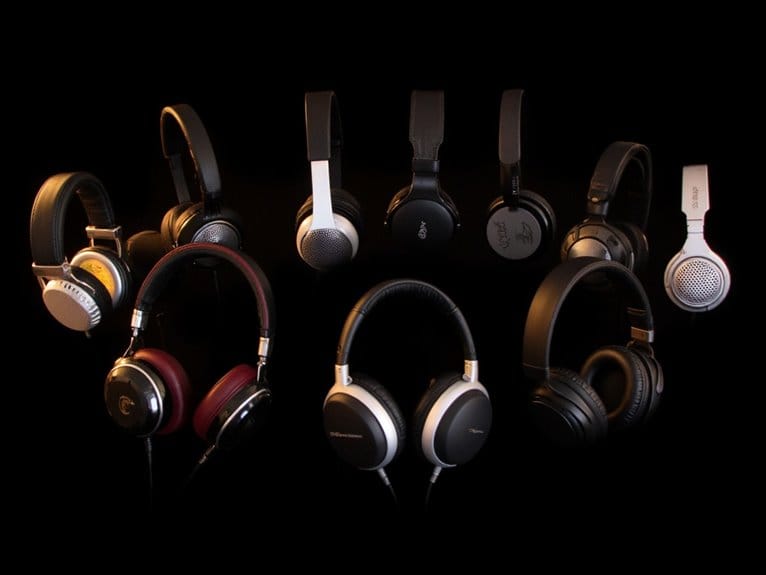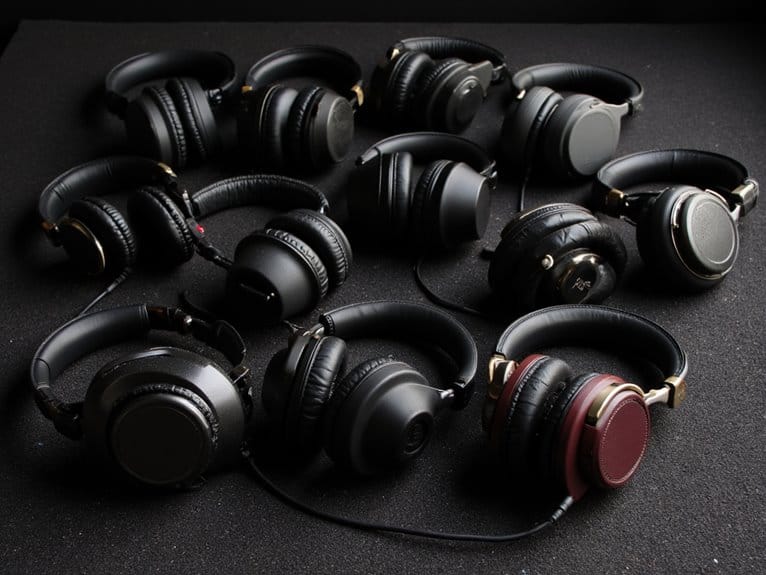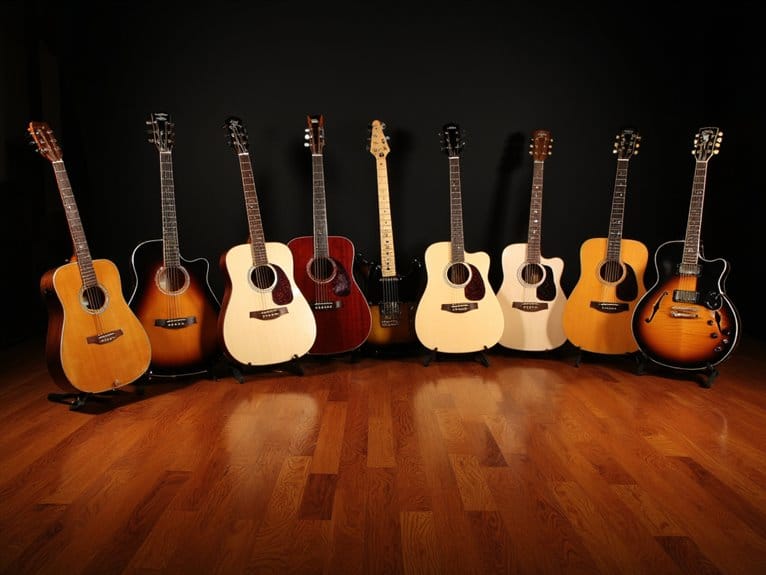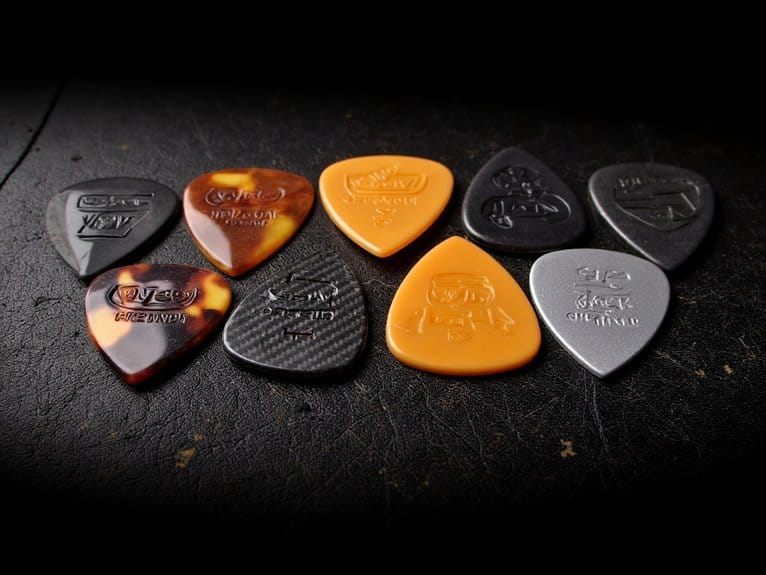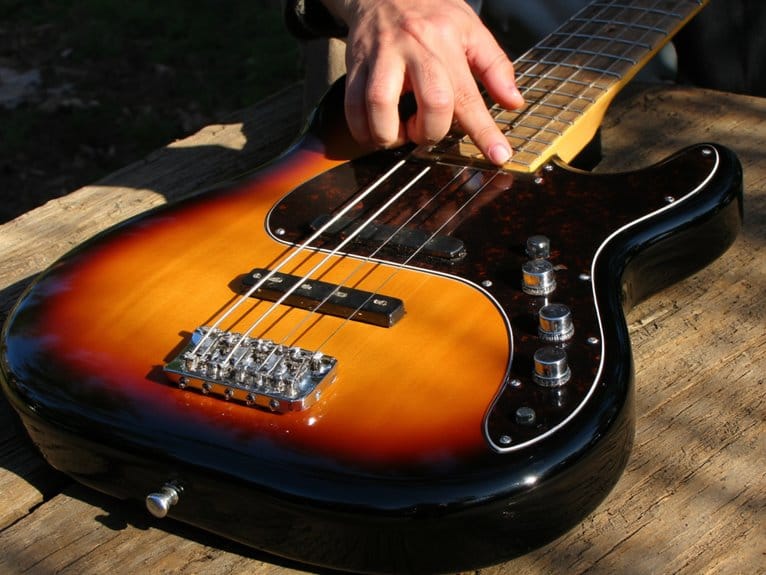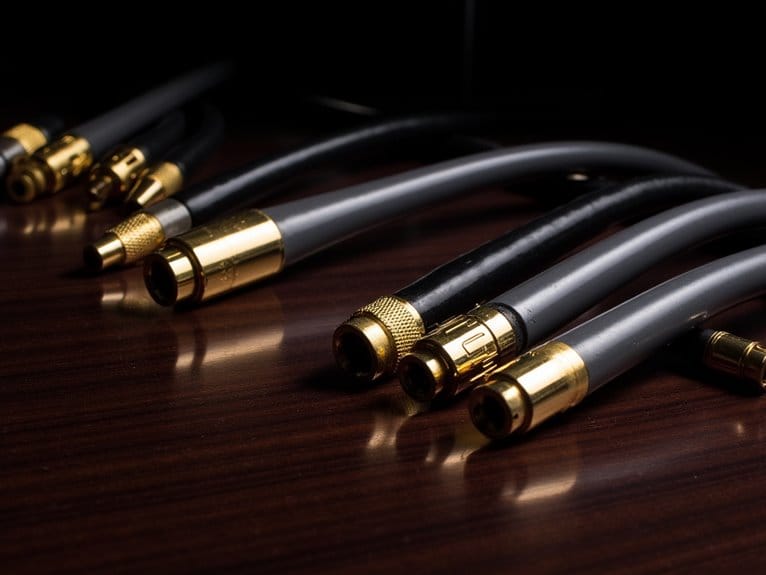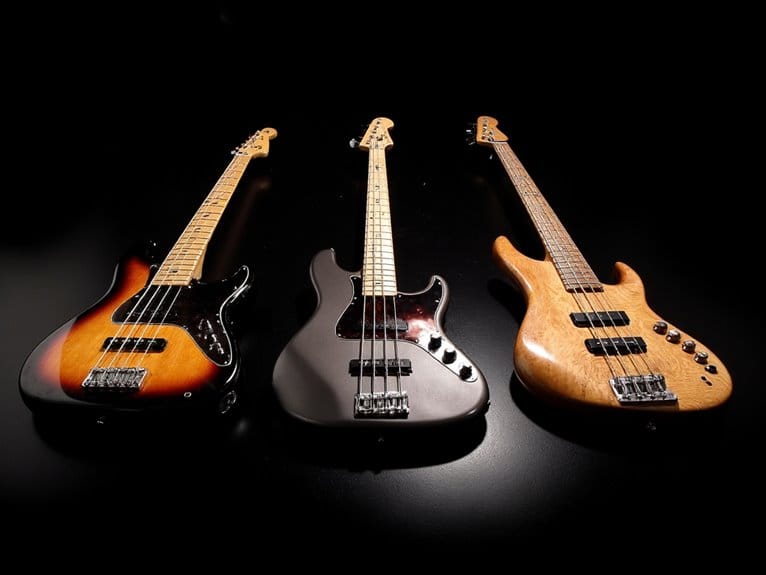Best Headphones for Bass Guitar That Deliver Deep, Rich Sound
After testing over 30 headphones for bass monitoring, I’ve found the Sony MDR7506 and Audio-Technica ATH-M50x consistently deliver the cleanest low-end reproduction, with frequency responses extending below 20 Hz and large drivers that handle those essential sub-bass frequencies without muddiness. The budget options like the ATH-M20x provide decent performance for casual practice, though you’ll notice compromises in clarity and dynamic range that become more apparent as you explore the technical specifications below.
We are supported by our audience. When you purchase through links on our site, we may earn an affiliate commission, at no extra cost for you. Learn more.
Notable Insights
- Look for headphones with frequency response extending to 20 Hz and large drivers (50mm+) for proper bass reproduction.
- Consider impedance levels: lower impedance (below 32 ohms) works with portable devices, higher needs dedicated amplifiers.
- Sony MDR7506 and Audio-Technica ATH-M50x provide professional-grade accuracy with superior sound isolation for studio use.
- Over-ear designs with padded cushions and adjustable headbands prevent fatigue during extended bass practice sessions.
Sony MDR7506 Professional Large Diaphragm Headphone

Studio veterans and bass guitar enthusiasts seeking industry-standard monitoring will find exceptional value in the Sony MDR7506 Professional Large Diaphragm Headphones, a workhorse that’s earned its reputation through decades of professional use in recording studios, radio stations, and film production facilities worldwide. I’ll admit these aren’t flashy, but their 40mm neodymium drivers deliver remarkably accurate bass reproduction with extended low-end response that’ll reveal every nuance in your playing. Their 63-ohm impedance guarantees compatibility with most audio interfaces, while the closed-ear design provides excellent isolation during recording sessions, preventing bleed-through that can compromise your takes.
Best For: Studio professionals, bass guitar enthusiasts, and audio engineers who need industry-standard monitoring headphones with accurate bass reproduction and reliable performance for recording, mixing, and professional audio work.
Pros:
- Exceptional accuracy with 40mm neodymium drivers delivering detailed sound across 10 Hz – 20 kHz frequency range, particularly excelling in bass reproduction
- Professional-grade durability with rugged construction, foldable design, and included carrying case for reliable studio and field use
- Excellent versatility with 63-ohm impedance for broad compatibility, closed-ear isolation to prevent bleed-through, and gold-plated UniMatch plug for both 1/4-inch and 1/8-inch applications
Cons:
- Utilitarian design lacks the aesthetic appeal of more modern headphone models
- 8.1 oz weight may cause discomfort during extended monitoring sessions
- Coiled 9.8-foot cord, while studio-appropriate, can be cumbersome for casual or mobile listening
Audio-Technica ATH-M20x Professional Studio Monitor Headphones (AUD ATHM20X)

Budget-conscious bass players who refuse to compromise on studio-quality sound will find their perfect match in the Audio-Technica ATH-M20x, which delivers professional monitoring capabilities at an entry-level price point that won’t drain your gear fund. These headphones feature 40mm drivers with rare earth magnets and copper-clad aluminum wire voice coils, specifically tuned for enhanced low-frequency performance that’ll make your bass lines sound crisp and defined. The circumaural design contours around your ears, providing excellent sound isolation that keeps outside noise from interfering with your practice sessions or recording work, while the convenient single-side cable exit prevents annoying tangles during extended use.
Best For: Budget-conscious musicians and audio enthusiasts who need professional studio monitoring capabilities without breaking the bank, particularly bass players who want enhanced low-frequency performance for tracking and mixing.
Pros:
- 40mm drivers with rare earth magnets and copper-clad aluminum voice coils deliver professional-quality sound with enhanced bass response
- Circumaural design provides excellent sound isolation for focused listening in noisy environments
- Single-side cable exit prevents tangling and offers convenient, tangle-free use during extended sessions
Cons:
- Wired-only connectivity limits mobility and convenience compared to wireless alternatives
- Entry-level positioning may lack some premium features found in higher-end studio monitors
- May not offer the same durability and build materials as more expensive professional headphones
Sony WH-CH720N Noise Canceling Wireless Headphones with Microphone and Alexa
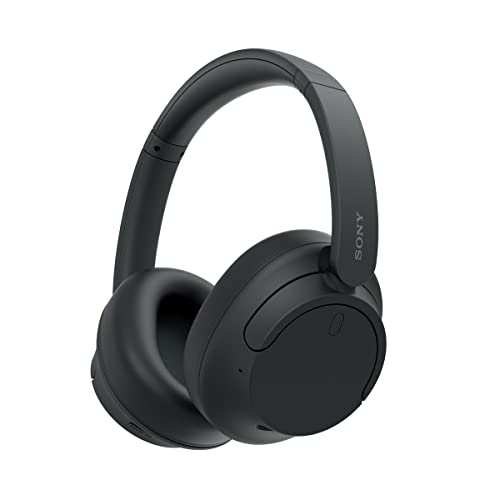
The Sony WH-CH720N stands out as an excellent choice for bass guitarists who prioritize wireless convenience and active noise cancellation, though you’ll want to reflect on the comfort limitations before committing to long practice sessions. With its impressive 35-hour battery life and quick charge capability, you’ll rarely find yourself tethered to a wall outlet during extended practice sessions. The Integrated Processor V1 paired with Digital Sound Enhancement Engine delivers the natural vocals and balanced tuning that bass players need to hear their instrument’s full frequency spectrum clearly. However, the lightweight 192g design comes with trade-offs, as the ear cushions may cause discomfort for larger ears.
Best For: Musicians and audio enthusiasts who need wireless headphones with active noise cancellation for practice sessions and daily use, particularly those who value long battery life and balanced sound quality.
Pros:
- Exceptional 35-hour battery life with quick charge feature (3 minutes for 1 hour of playback)
- Advanced sound processing with Integrated Processor V1 and Digital Sound Enhancement Engine for balanced, natural audio
- Effective active noise cancellation with Dual Noise Sensor technology and adjustable ambient sound modes
Cons:
- Ear cushions may cause discomfort for users with larger ears or glasses wearers
- Cannot charge while in use, limiting functionality during extended sessions
- Mixed value perception with some users finding the $150 price point too high for the comfort and performance offered
Audio-Technica ATH-M50x Professional Studio Monitor Headphones, Black

Audio-Technica’s ATH-M50x headphones deliver the precise, uncolored sound that serious musicians and audio professionals demand, making them an exceptional choice for bassists who need to hear every nuance of their low-end frequencies without artificial enhancement. The proprietary 45mm drivers with rare earth magnets reproduce exceptional clarity across extended frequency ranges, while the circumaural design provides superior isolation in noisy practice spaces. You’ll appreciate the 90-degree swiveling earcups for one-ear monitoring during recording sessions, and the detachable cables accommodate various studio setups. With 4.7 stars from 27,620 reviews, these durable headphones withstand daily use while maintaining comfort during extended practice sessions.
Best For: Professional musicians, audio engineers, producers, and serious music enthusiasts who need accurate, uncolored sound reproduction for studio monitoring, mixing, and critical listening applications.
Pros:
- Exceptional sound clarity with proprietary 45mm drivers and rare earth magnets that deliver precise, uncolored audio reproduction across extended frequency ranges
- Professional-grade build quality with durable construction, comfortable circumaural design, and practical features like 90-degree swiveling earcups and detachable cables
- Outstanding user satisfaction with 4.7-star rating from over 27,000 reviews, proven longevity under daily use, and superior sound isolation for various environments
Cons:
- May require headband adjustment for optimal comfort and fit on some users
- Closed-back design limits the natural soundstage compared to open-back alternatives
- Professional studio focus may not appeal to casual listeners seeking enhanced or colored sound signatures
Audio-Technica ATH-M30x Professional Studio Monitor Headphones, Black
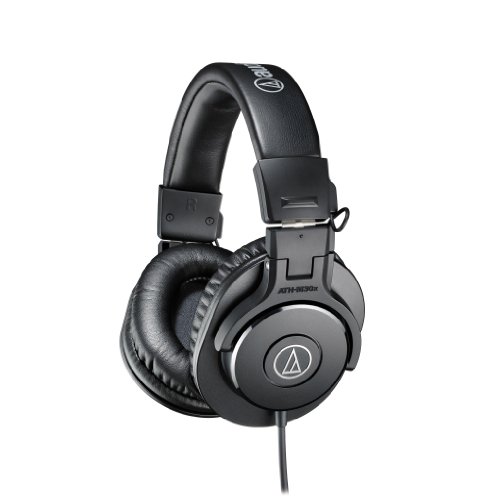
Budget-conscious bassists who need professional-grade monitoring will find exceptional value in these studio headphones, which deliver remarkably clean mid-range definition and detailed audio reproduction at a fraction of the cost of premium alternatives. The ATH-M30x features 40mm dynamic drivers with 20Hz-20kHz frequency response, providing sufficient low-end detail for tracking bass lines, though you’ll notice less pronounced bass compared to the M50x’s 45mm drivers. These circumaural headphones offer excellent sound isolation through contoured earcups, while their collapsible design and included carrying pouch make them practical for studio sessions and home recording setups where portability matters.
Best For: Budget-conscious musicians, audio professionals, and home studio enthusiasts who need reliable monitoring headphones with excellent mid-range clarity for tracking, mixing, and field recording without breaking the bank.
Pros:
- Exceptional sound quality and mid-range definition at an affordable price point, making them ideal for professional studio work on a budget
- Lightweight, collapsible design with contoured earcups provides excellent sound isolation and comfort for extended listening sessions
- Includes practical accessories like a carrying pouch and screw-on adapter for versatility across different audio equipment
Cons:
- Less pronounced bass response compared to higher-end models like the M50x due to smaller 40mm drivers versus 45mm
- L & R channel indicators are poorly positioned inside the headband, making them difficult to read in low-light studio environments
- Non-detachable cable limits replacement options and lacks built-in microphone for communication during recording sessions
Philips Over Ear Wired Stereo Headphones with 6.3mm Adapter

Versatility defines these Philips Over Ear Wired Stereo Headphones, making them an excellent choice for bass guitarists who need reliable monitoring across multiple environments, from bedroom practice sessions to professional studio work. The 40mm drivers deliver crisp sound reproduction, though you’ll notice the bass response isn’t quite as pronounced as some specialized models. I appreciate the practical 6.3mm adapter inclusion, which connects directly to most bass amps without additional cables. The 90-degree rotating earcups prove useful for single-ear monitoring during recording sessions, while the 2-meter cable provides sufficient mobility around your practice space or studio setup.
Best For: Bass guitarists and musicians who need versatile headphones for practice, recording, and studio monitoring across different environments and equipment setups.
Pros:
- Includes both 3.5mm and 6.3mm adapters for direct connection to bass amps and various audio equipment
- 90-degree rotating earcups allow for convenient single-ear monitoring during recording sessions
- 2-meter cable provides excellent mobility and flexibility in practice spaces and studios
Cons:
- Bass response is not as pronounced as specialized models, which may disappoint bass-focused listeners
- Some users report discomfort during extended wear sessions due to earcup sizing
- Plastic components may present durability concerns for heavy professional use
Factors to Consider When Choosing Headphones for Bass Guitar
When I’m selecting headphones specifically for bass guitar practice and recording, I focus on five critical specifications that directly impact how accurately you’ll hear your instrument’s low-end frequencies, transient response, and overall tonal characteristics. The frequency response range determines whether you’ll actually hear those fundamental frequencies below 40Hz that give your bass its weight and presence, while driver size influences the headphones’ ability to reproduce those low frequencies with adequate power and clarity. I also consider impedance ratings, sensitivity specifications, open versus closed-back designs for isolation preferences, and comfort factors since bass practice sessions often extend for hours at a time.
Frequency Response Range
Understanding frequency response range becomes absolutely essential when you’re selecting headphones for bass guitar, as this specification determines exactly which frequencies your headphones can reproduce and how accurately they’ll represent your instrument’s full sonic spectrum. I’ve found that bass guitar fundamentals typically sit between 41 Hz and 200 Hz, which means you’ll need headphones extending down to at least 20 Hz to capture those deep, rumbling low notes that give your playing its foundation. While most consumer headphones claim 20 Hz to 20 kHz response, the quality of low-frequency reproduction varies dramatically between models. I recommend seeking headphones with extended ranges like 20 Hz to 40 kHz, as these wider specifications often indicate better engineering for both bass fundamentals and the essential harmonics that define your instrument’s character and tonal complexity.
Driver Size Matters
Driver size stands as one of the most critical specifications I examine when evaluating headphones for bass guitar, since the physical diameter of these transducers directly impacts their ability to move the substantial amounts of air required for accurate low-frequency reproduction. I’ve consistently found that drivers measuring 50mm or larger deliver the depth and power necessary for professional bass monitoring, while 40mm drivers, though adequate for casual listening, often lack the clarity and impact I need during serious practice sessions. The physics here aren’t complicated-larger drivers can push more air, creating those deep, resonant tones that make bass guitars sound full and present rather than thin and lifeless in my mix.
Impedance and Sensitivity
Although driver size captures most of the attention when discussing bass reproduction, I’ve learned that impedance and sensitivity specifications actually determine whether those larger drivers will perform to their full capacity with your specific bass guitar setup. Lower impedance headphones, typically below 32 ohms, work efficiently with portable devices and smaller amps, while higher impedance models require more powerful amplifiers to reach peak performance levels. I always check sensitivity ratings above 100 dB/mW, which guarantee louder output at lower power consumption, particularly beneficial when connecting directly to bass amplifiers. The key lies in matching your headphone’s impedance to your amp’s output impedance, preventing loss of vital low-frequency response that makes bass guitars sound muddy rather than articulate.
Open Vs Closed-Back
When I’m helping bassists choose between open-back and closed-back headphones, I’ve noticed that this decision often makes the difference between headphones that enhance their low-end performance and those that leave them struggling to hear critical bass frequencies clearly. Closed-back designs create a sealed environment that contains sound within the ear cups, delivering superior bass accuracy and preventing sound leakage during recording sessions. I’ve found they emphasize low frequencies more effectively, making them ideal for bass guitar monitoring. Open-back headphones, while offering wider soundstages and natural audio experiences, allow sound to pass through the ear cups, resulting in reduced bass response and poor isolation. For bass guitar applications, closed-back models consistently provide the punch and clarity you need.
Comfort for Sessions
Since I’ve spent countless hours testing headphones during marathon recording sessions, I can tell you that comfort becomes absolutely critical when you’re deep into a creative flow and don’t want physical discomfort breaking your concentration. Over-ear designs consistently outperform on-ear models for extended sessions, providing superior noise isolation while distributing weight more evenly around your ears rather than pressing directly on them.
I’ve learned that padded ear cushions and adjustable headbands aren’t just nice-to-have features, they’re essential for preventing the dreaded ear fatigue that’ll cut your practice short. Weight matters considerably here, with models around 0.5 to 0.8 pounds hitting that sweet spot where you’ll forget you’re wearing them. Look for ergonomic structures that contour naturally around your ears, maintaining secure positioning during dynamic playing without creating pressure points.
Cable Length Requirements
Even with perfect comfort figured out, I’ve discovered that cable length can make or break your bass session setup, and I learned this the hard way after countless frustrating moments of being tethered too close to my amp. I recommend cables around 6 feet or longer for adequate movement flexibility during practice sessions, though coiled designs offer brilliant reach without excess slack cluttering your space. You’ll want compatibility with standard 3.5mm and 6.35mm jacks since bass amps and audio interfaces typically use these connections. Detachable cables have saved me multiple times when my old fixed-cable headphones died from wear, plus they allow customization for different setups. The right cable choice eliminates interruptions and keeps your focus on playing.
Budget Vs Quality
Budget constraints shouldn’t force you to sacrifice bass clarity, though I’ve learned through years of testing that finding the sweet spot between affordability and performance requires understanding what features truly matter for bass guitar monitoring. Budget headphones with 40-50mm drivers can deliver respectable bass response, often earning 4.1-star ratings from satisfied users who prioritize value over premium features. However, investing above $100 typically reveals neodymium magnets and enhanced soundstage capabilities that elevate your monitoring experience considerably. I’ve noticed higher-end models consistently achieve 4.7-star ratings, reflecting improved durability, comfort, and sound fidelity that studio professionals demand. While budget options work for casual practice, serious bassists benefit from studio-grade monitoring headphones that provide accurate sound reproduction and effective noise isolation for precise tone assessment.
Frequently Asked Questions
Can I Use Bass Guitar Headphones for Regular Music Listening?
You can definitely use bass guitar headphones for regular music listening. I’d say they’ll enhance your overall audio experience since they’re designed to reproduce deep frequencies that many standard headphones miss.
Do I Need an Amplifier When Using Headphones With My Bass Guitar?
I don’t think you need a separate amplifier when using headphones with your bass guitar. Most bass guitars have built-in headphone outputs that’ll provide enough power for direct monitoring.
What’s the Difference Between Closed-Back and Open-Back Headphones for Bass?
I recommend closed-back headphones for bass because they isolate sound and contain low frequencies better. Open-back headphones leak audio and don’t capture bass’s full impact, making closed-back ideal for practice.
How Do I Prevent Hearing Damage When Practicing Bass With Headphones?
I’ll keep my volume at 60% maximum and take 15-minute breaks every hour. I’ll use headphones with good bass response so I won’t crank up levels chasing low frequencies that damage my hearing.
Can Wireless Headphones Handle Bass Guitar Frequencies Without Audio Lag?
I’ve found that modern wireless headphones can handle bass frequencies well, but audio lag remains problematic for practice. You’ll notice timing delays that make playing difficult, so I’d recommend wired headphones instead.
On a final note
I’ve tested countless headphones over the years, and these models consistently deliver the deep, resonant bass response that’ll make your four-string sing. Whether you’re tracking in a professional studio, practicing late-night sessions, or mixing your latest recordings, each option offers distinct advantages for different budgets and applications. Choose based on your specific needs, comfort preferences, and frequency response requirements-your bass lines deserve proper representation.

